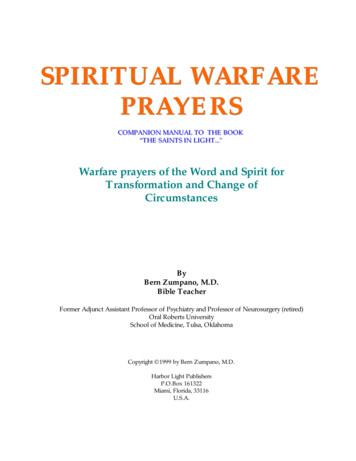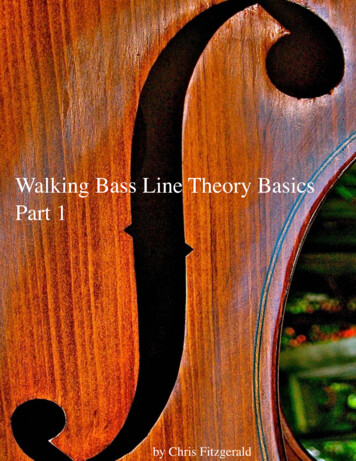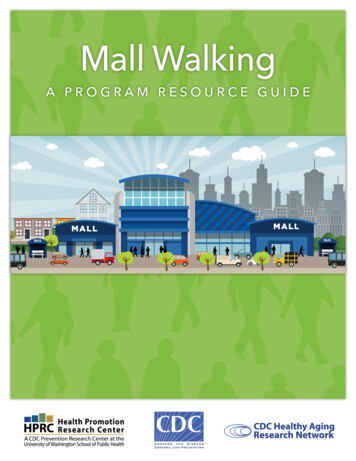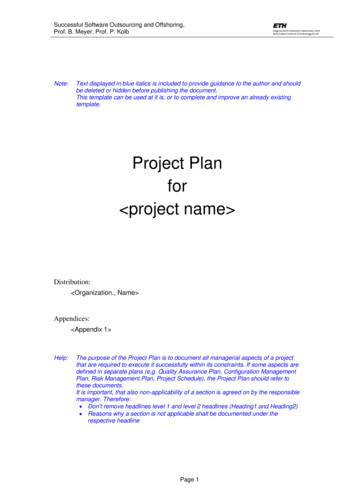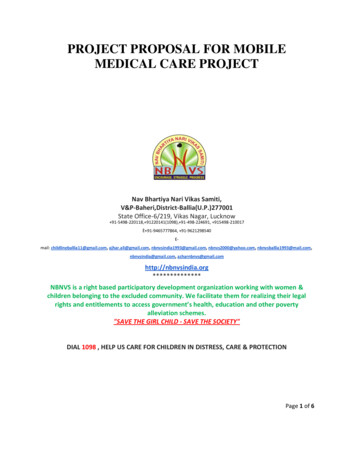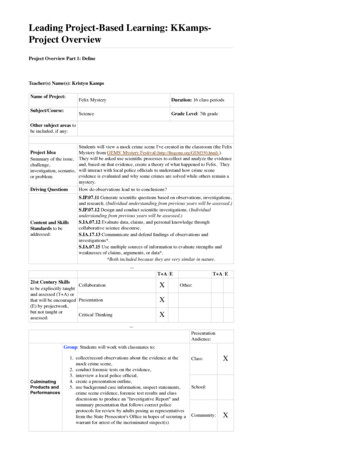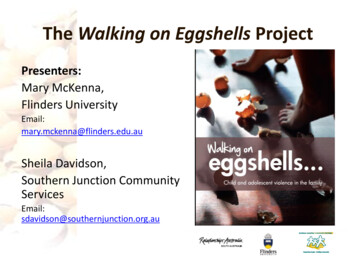
Transcription
The Walking on Eggshells ProjectPresenters:Mary McKenna,Flinders UniversityEmail:mary.mckenna@flinders.edu.auSheila Davidson,Southern Junction org.au
Overview Project BackgroundResourcesSA lawChallengesProfessional considerationsWhere the rubber hits the road
Background A collaborative project Respectful relationships in the family through sustainingknowledge exchange about child and adolescent violence inthe home.– Researchers– Practitioners working with Families Young people Parents
2010 Dark side of parenting report identified a singthe-dark-side-of-parenting.cfm Initially funded in 2011 by a grant from FlindersUniversity Currently self funding through– Voluntary contributions– Sale of parent sources/– Charge for professional development training
ParentInformationBooklet
The Information Card6
The package ProfessionalDevelopmentInformation Package In conjunction with aprofessional trainingsession.
Professional development package Framework for understanding child and adolescentviolence in the home Australian and South Australian Context Risk and Protective Factors Service System in South Australia Case Studies and Strategies Some Counselling Approaches Support Groups and Agencies
Future of the project Continuing educationPresentations to various groupsOngoing dialogue with multiple agenciesTranslating resources to suit diverse culturaland language groups Being alert to ongoing opportunities toengage professionals and the community
The Young Offenders Act (SA) 1993 Covers illegal behaviour by young people aged10 to 18 Diversion for less serious offences where theoffence is admitted: informal caution, formalcaution, family conference More serious offences, recidivism or whereoffence denied: Court
Intervention Orders (Prevention ofAbuse) Act SA 2009 enacted Dec 2012 Broadened to include young people asperpetrators and/or victims of abuse Intervention orders can be issued for risk Conditions may be imposed Limits on contact may be imposed Too early yet to ascertain if this Act has beenuseful to address adolescent family violence
Challenges The problem is conceived of differently bydifferent professionals Different philosophical and ideologicalapproaches Different theoretical approaches Different ways of defining the problem Important to support all family members whilebeing vigilant about safety
Our beliefs Influenced by our professional training andpractice But also by our personal world views– Influenced by our values– Experiences– Successes and failures
Reflections for professionals What are my professional and personal views? What skills and experience can I contribute ? How can I maintain an ethical stance and avoid my ‘stuff’getting in the way? How can I engage meaningfully with children/adolescentsand families ? How can I engage and work with colleagues to ensure weare working toward the same goals for the child/adolescentand the family? How can I support colleagues working with thechild/adolescent and the family? What collegiate support would help me in working with andunderstanding this issue?
MythOrReality?
Numerous approachesPhysical safety first Behavioural vs therapeutic approaches Family / systems therapy Psychological / psychiatric diagnoses Age of child informs choice of therapeuticframework Medicalisation of the behaviour
Potentially useful therapies andapproaches Strengths based approachesNarrative therapyFeminist frameworkCognitive Behaviour TherapyEddie Gallagher’s approachNon-Violent ResistanceSystems Therapy- Alan Jenkins
General principles Violence is generally a purpose driven behaviour thatbrings significant rewards What is the context in which this behaviour occurs? It is difficult to look at violence without considering thedynamics of power, responsibility and entitlement Therapy should be aimed at assisting those who behaveviolently to take more responsibility The Jenkins’ Question: Do our interventions increase ordecrease responsibility?
An holistic approach Working collaboratively Understanding the ‘bigger picture’– Considering the problem from diverseperspectives The family including siblings and extended familyThe parentThe young personThe community
Working with families Practices that encourage open and positivecommunication Encourage respectful relationships Build on parents’ strengths and recognise andcelebrate strengths of children Encourage and enable young person’s communicationskills Building pathways for young people to be successful Increase child’s awareness of choices andconsequences
Working with parents You may be the first (and possibly the last) encounterthe family has with an outside agency Tell them that they are not alone living with thisproblem and that change is possible Any professional interaction with the young personshould support the notion that the parent is the ‘boss’in the family Encourage the parent(s) to seek help, even if theyoung person refuse to be part of it
Working with parentsUnhelpful responses Telling them what to do Blaming them or implying it is their fault Criticising the way they are managing thesituation Assuming a history of violence Undermining parenting skills
Working with young people Safety firstLook for ‘windows of opportunity’Work collaboratively with othersSupport programsEncourage participation in positive activitiesAccommodation optionsPositive engagement without colludingConsequences
Reflections for professionals What are my professional and personal views? What skills and experience can I contribute ? How can I maintain an ethical stance and avoid my ‘stuff’getting in the way? How can I engage meaningfully with children/adolescentsand families ? How can I engage and work with colleagues to ensure weare working toward the same goals for the child/adolescentand the family? How can I support colleagues working with thechild/adolescent and the family? What collegiate support would help me in working with andunderstanding this issue?
Important points to remember Interaction and intervention need to support thepower/authority of the parents Be mindful not to inadvertently give power to thechild over the parent Young people are responsible for their ownbehaviour It’s not about blame/shame Above all:Safety first
Questions, clarification, comments?
The Walking on Eggshells Project Presenters: Mary McKenna, Flinders University Email: mary.mckenna@flinders.edu
